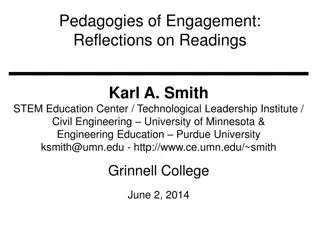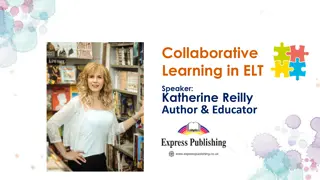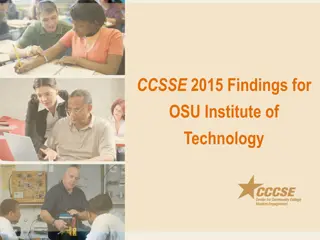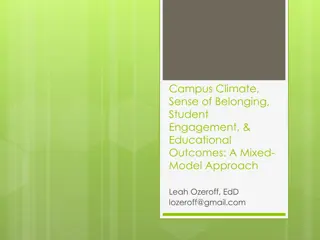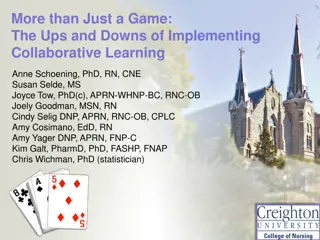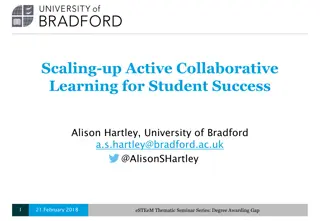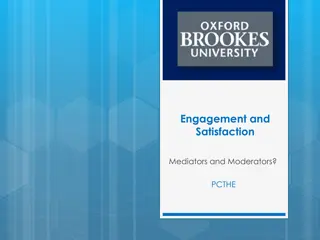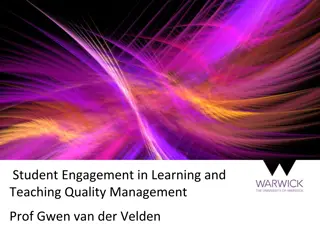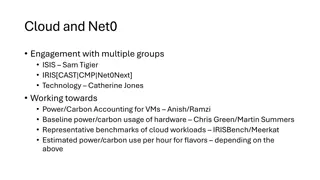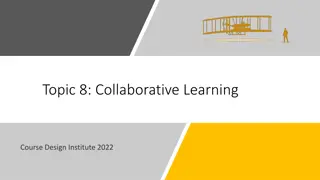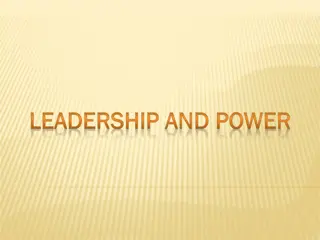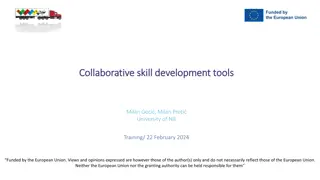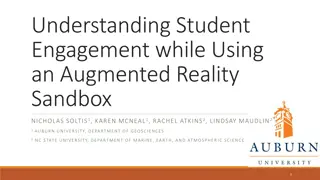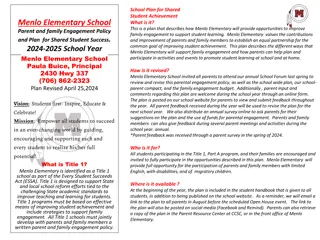Collaborative Education - The Power of Student Engagement
Engaging students in the learning process is a collaborative effort that involves stimulating and inspiring them rather than merely instructing. By focusing on optimizing learning conditions, educators can create dynamic environments that encourage critical thinking and active participation, ultimately enhancing student motivation and satisfaction.
Download Presentation

Please find below an Image/Link to download the presentation.
The content on the website is provided AS IS for your information and personal use only. It may not be sold, licensed, or shared on other websites without obtaining consent from the author. Download presentation by click this link. If you encounter any issues during the download, it is possible that the publisher has removed the file from their server.
E N D
Presentation Transcript
No matter your pedagogical choice, the act of educating is not something you do to students; it s something you do with students. Dr. Ed Nuhfer Director, Center for Educational Effectiveness Humboldt State University
The plan for this workshop . . . The plan for this workshop . . . Some brief set up work A bunch of our time working in small groups Debrief all together
Two IDEA student survey questions Describe the frequency of your instructor s teaching procedures (responses - hardly ever, occasionally, sometimes, frequently, always)
Two IDEA student survey questions Describe the frequency of your instructor s teaching procedures (responses - hardly ever, occasionally, sometimes, frequently, always) #8: Stimulated students to intellectual effort beyond that required by most courses #15: Inspired students to set and achieve goals which really challenged them
The motivation spectrum Extrinsic - - - - - - - - - - - - - - - - Intrinsic
The motivation spectrum Extrinsic - - - - - - - - - - - - - - - - Intrinsic Rarely is motivation entirely one or the other People with higher life satisfaction are more able to turn extrinsic motivations into intrinsic motivations Extrinsic - - - - - - - - - - - - - - - - Intrinsic
We are talking about stimulating and inspiring students to act and think in a certain way about their efforts This is not the same as requiring or compelling them to complete a task
We are talking about stimulating and inspiring students to act and think in a certain way about their efforts This is not the same as requiring or compelling them to complete a task We are talking about optimizing learning conditions This is about a dynamic environment It s a function of design and delivery
No matter your approach to teaching, these conditions are necessary to increase student motivation and lead to higher intellectual effort and setting and achieving goals. 1. Do your students trust you as their learning guide?
No matter your approach to teaching, these conditions are necessary to increase student motivation and lead to higher intellectual effort and setting and achieving goals. 1. Do your students trust you as their learning guide? 2. Can your students clearly describe your expectations? Do they know what success looks like? Can they use your feedback to improve?
No matter your approach to teaching, these conditions are necessary to increase student motivation and lead to higher intellectual effort and setting and achieving goals. 3. Are your students emotionally invested in learning what you are teaching in the course?
No matter your approach to teaching, these conditions are necessary to increase student motivation and lead to higher intellectual effort and setting and achieving goals. 3. Are your students emotionally invested in learning what you are teaching in the course? 4. Do your students see a viable path to meeting your learning goals for the course?
Four questions to discuss within your small groups. For each question: First, you will address the question in your small groups Second, I ll touch on some things that seem to be effective for that question Third, you will think about ways of applying these ideas to your activity in your small groups
Getting to know each other . . . Explain to each other the activity or portion of your course that you want to think about during this workshop What is its role in the course? What do you like about it? What concerns you about it?
Specifically, what do you do and/or say that increases your students trust in you as you guide them through the learning of this particular activity or portion of the course?
Students need to know that you: Care for them as people Believe in their ability to succeed Will try to adapt your efforts to help them learn Will teach them what they need to know
Specifically, what do you do and/or say to clearly articulate the nature of your expectations, the way that students can demonstrate that they have met them, and the way in which you will assess their efforts?
Students need: More than just a spoken treatise on expectations Some ways that are effective in communicating . . . Rubrics, Examples of prior work Feedback designed to guide future improvement Students experience that you play by your own rules
Specifically, what do you do and/or say to help students emotionally invest in learning during your chosen activity or portion of the course?
Students need to know: How the learning gained in this class can improve the student s quality of life The implications of learning new skills and knowledge The value of learning to learn
Specifically, what do you do and/or say to show students a viable pathway from the beginning of the activity or portion of the course to its successful completion?
Students need to know: That there is a viable, step-by-step process through the learning experience That each step flows from the last and sets up the next That the learning from each step sets up success in other parts of the activity or portions of the course
Based on these conversations, what are one or two ideas that you think might best improve your activity or course? Use each other s expertise to brainstorm or evaluate together.
None of this is foolproof Its all about likelihoods, not certainty Learning environments are dynamic and need consistent attention Your small group doesn t have to end today!

 undefined
undefined












